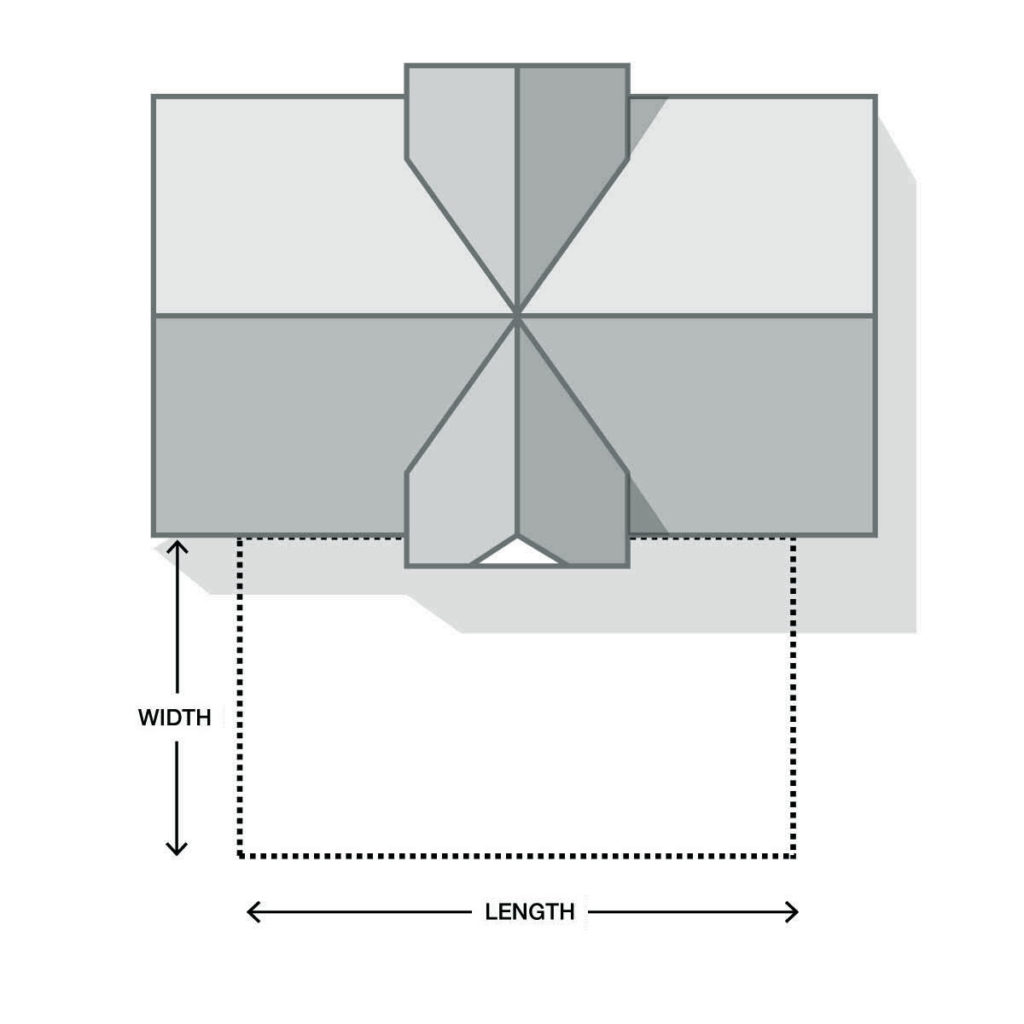Armadillo’s Complete Guide to Composite Decking
Everything to Know About Composite Decking
A composite deck is one of the best upgrades you can make to your home. You’ll dramatically improve the amount of outdoor living space and greatly enhance the appearance of your home. The Complete Guide to Composite Decking will help you understand the basics of designing, building, and enjoying your composite deck from start to finish. This helpful guide for homeowners will give you all the information and tips you need to successfully build and enjoy your dream deck.

Why you should build an outdoor deck
It’s easy to become overwhelmed by the number of options available when considering which kind of decking material will best suit your needs. However, one thing is clear: there are many reasons to construct an outdoor deck. Whether it’s as simple as wanting somewhere sheltered and pleasant with which to relax on warm days or a luxurious addition with extra space for hosting barbecues in style‚ a deck is worth considering if you want an attractive outdoor living space to enjoy with friends and family,
Why composite decks are superior to treated lumber decks
Composite decks have grown enormously in popularity, in part because they add extra value to your home. Not only is a deck an excellent place for outdoor entertaining, but you can also choose designer patterns or colors so that your outdoor deck complements your home. Another reason to choose composite decking is that the material will last longer and require less maintenance than traditional hardwoods. And composite decking doesn’t warp, shrink, rot or splinter the way that treated lumber can. See this article for more information about comparing composite decking to wood, Which is better: composite decking or wood decking, as well as an article on decking materials, What Decking Material Should You Use For Your Exterior Deck.
Planning Your Composite Deck
Early on, you should decide if you want your composite deck to be attached to the house or free-standing, as this affects the construction process and cost. However, this decision will also affect many aspects of the job, including deck size, location of post footings, railings, and stairs. Both ways have pros and cons, but generally speaking, most people prefer an attached deck that seamlessly transitions from indoors to out. However, many homeowners prefer a free-standing composite deck that’s not too close to the house to be more surrounded by natural beauty.
Planning an outdoor deck plan isn’t rocket science, but there are some basic things to consider before you start looking for contractors to build your deck. The most important thing is that you think about how much use the space will get and prioritize accordingly: for example, if you’re a family of four, kids are going to be running around and bring over plenty of classmates and teammates, so your needs are going to be a lot different than a retired couple who wants somewhere lovely to sit and enjoy peaceful hours reading and sipping iced tea.
The next thing to consider is lighting and electricity. Outdoor lighting lets you enjoy your new deck late into the evening, and well-placed outlets will allow you to plug in portable speakers or tools for yard work like grass trimmers or hedge clippers. On the other hand, solar-powered lights can really make your deck come alive at night without the need for expensive electrical work.
Looking for inspiration? Check out our composite decking inspiration gallery and then read this article, “How to build a better deck: 7 strategies and ideas.”
Calculating the size of your composite deck
When planning your new deck, you first need to determine your budget. Decks can be very affordable or extravagant, and defining a realistic budget can mean the difference between a simple DIY build and a contractor building a multi-level deck with railings, stairs, and built-in seating. It’s worth doing some rough calculations to gauge how much space you expect your deck to occupy before moving forward with any designs or materials. Read this article, “What Size Should My Deck Be,” for more details.
Features for your composite deck
Once you’ve settled on the size of your composite deck, it’s time to add in all the extras! A built-in bench is a helpful addition if you want somewhere to sit without the expense of purchasing patio furniture. Solar lights or garden lanterns are great additions for creating a romantic and relaxing atmosphere at night. While they’re inexpensive, they can make a big difference to how often you actually use your beautiful new deck. If you enjoy entertaining, consider adding an outdoor kitchen. For more ideas, check out our article “How to build a better deck: 7 strategies and ideas.”
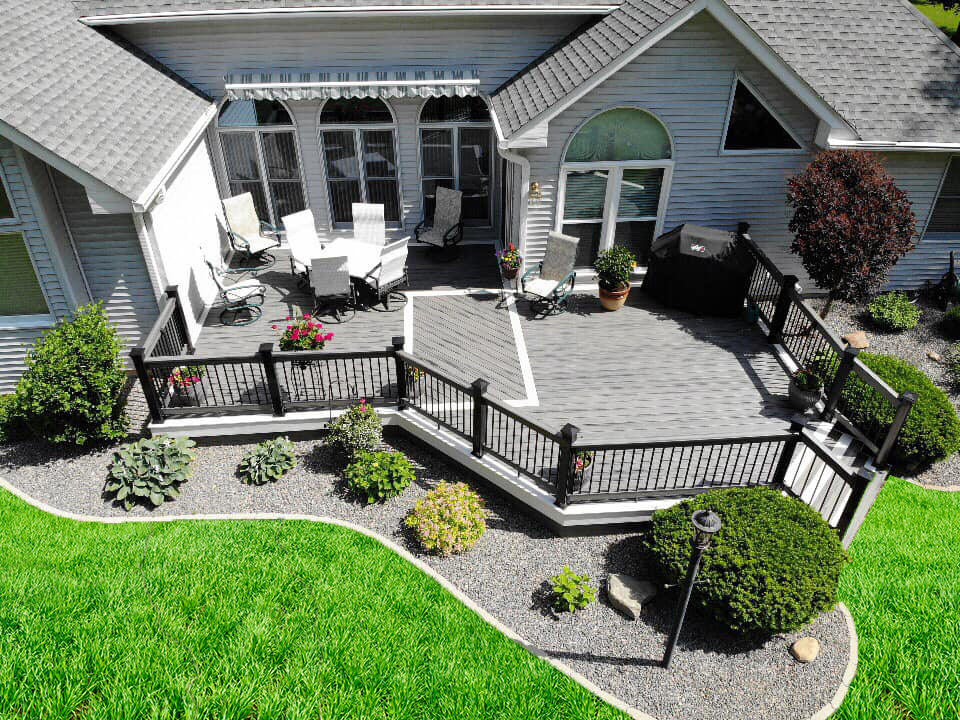
Where to locate your outdoor deck
As we mentioned, you can place your outdoor deck next to your home to expand your living space, or you can place your deck away from your home to create a separate area for outdoor living and activities. It’s important to carefully evaluate your lot: consider the position of trees, as they will drop leaves (and sometimes branches!), and their roots will make digging post holes more challenging. Consider how much or how little sun the area gets and when. Consider how visible or secluded your location will be; do you want to escape from your neighbors or regularly invite them over. For a more thorough exploration of this topic, check out 10 Tips for Deck Placement.
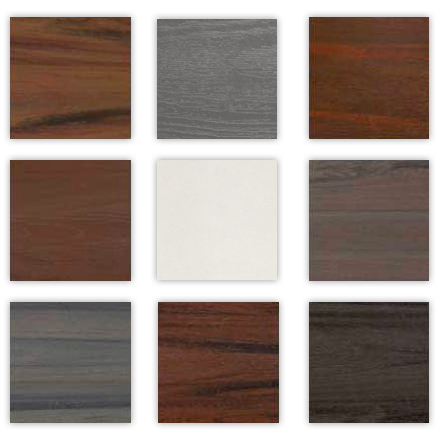 Choosing the color of your deck
Choosing the color of your deck
Designers are increasingly experimenting with bold colors in their deck designs, and this trend is also growing in popularity among homeowners. One of the most significant benefits of composite decking is the wide range of colors available, from rich browns to smoky grays. When choosing the color — or colors — of your decking, aesthetics aren’t the only thing to consider. Darker colors will naturally get hotter than light-colored decking when exposed to direct sunlight for long periods, so think about how much sun your deck gets before committing to your color choice. Our website is a great place to start, where you can see all the available Armadillo decking colors.

Estimating the cost of your composite deck
It’s helpful to prepare a budget before getting contractors involved — even if this means working on paper first. Consider the cost of materials and choose an option that works within your price range while still giving you wiggle room for other expenses like furniture or lighting fixtures.
Working with contractors
Hiring a contractor has two important benefits: speed and quality. Your local contractor has enormous experience building decks. While a homeowner might build one or two decks, a contractor will often build dozens of composite decks in a single season. Their experience and expertise will dramatically reduce the time required to build your deck. While building your deck might take a month or more, a professional builder, often working with a team, can complete the project in a week or two. That expertise also results in a better product: every aspect of the project, from digging holes for posts to the hardware used, will be high quality.
Keeping costs down
If you’re looking for tips on keeping costs down on your composite deck, we have a post that you may find helpful, How To Save When Building A Composite Deck. You should also give our Composite Deck Cost Estimator a try.
Building Your Composite Deck

Permits and approvals needed for an outdoor deck
Never build an outdoor deck without getting permission from your local government. If so, local authorities will often make you remove the deck entirely and start over — and can also issue fines or penalties. So make sure you meet all the requirements before moving forward with any designs. Different areas have different restrictions and varying degrees of helpfulness, but it’s essential to ask around and find out where you stand before you start working on your new deck! We’ve written a short article on this subject, Three things you need to have before building your deck.
Preparing the area for your outdoor deck
It’s helpful to remove any stones or bricks from the area where you want to install your composite deck. It’s worth doing a “test run” by marking the area with stakes and string or marking paint before getting contractors in so that you know what areas they’ll be working in and what obstacles or obstructions, such as tree roots, might exist.

Building the substructure of your outdoor deck
If you want to build a deck above ground level, one of the first steps is digging holes for posts. If your soil conditions are good — for example, there’s not too much sand or clay — the ground will be easy to dig. Use a power auger to drill your holes. A two-person auger makes the job much easier. You can rent these from a nearby Building Supply store or tool rental company. The hole diameter is based on the size of the footing, the concrete base in which your posts will set. Larger and taller decks need larger footings. In colder climates, make sure that the depth of the hole is beneath the frost line in your area. Then set and level your posts (usually 6 x 6 ground-treated lumber) and pour the cement for your footings.
Building the joists
Edge or rim joists run around the perimeter of your deck. These boards must be level and square before you add any additional joists. Measure diagonally from the upper left corner to the lower right. Then measure from the lower left to the upper right corner. When these two numbers match, your deck is square. Rim joists are secured to your posts with strong, weather-resistant hardware, often stainless steel lag bolts that are ½ inch in diameter and 4-5 inches long. Once the edge joists are in place, you can hang the remaining joists and install blocking if needed.
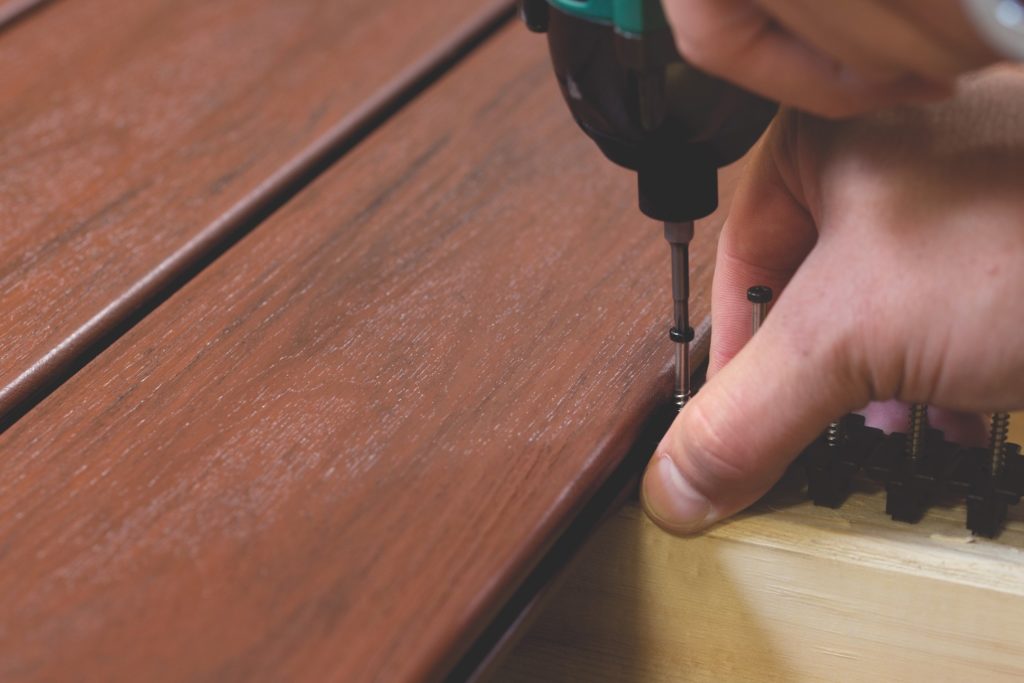
How to install the composite decking boards
A helpful tip when installing composite decking boards is to use hidden deck fasteners instead of screws. These are great since you won’t see them once everything’s in place. You can get these on-site from stores such as Lowes and Home Depot. Check out this great article about using hidden deck fasteners.
The specific process will vary depending on the board pattern you choose but generally works by starting at the edge and installing edge clips on the edge joist. Slide your decking board and secure the board to the substructure with hidden fasteners on every joist. Repeat this process with each decking board. This job goes far more quickly with two things: a cordless drill/drive to set your fasteners and a partner to work on one section of the board while you do another.
Try Our Decking Material Calculator
Board patterns for composite decking
A simple pattern is quicker to install and costs less, but you can install your decking in different designs to create a more dramatic appearance.

Grid pattern
One option is to divide the total area of your deck into smaller sections and then lay your decking boards in a grid pattern, where some boards are placed up and down, and other boards are placed right-to-left.
Diagonal pattern
Another eye-catching alternative is to place the decking boards at a 45-degree diagonal. This design creates a sense of movement and helps to draw the eye toward some feature of your home, such as the entryway.
Inset pattern
A simple way to emphasize one area is with an inset using a different color of decking. For example, an 8 x 8 inset where you plan to place an outdoor dining set. The inset can be a square or rectangle, so consider your deck’s proportions and how you plan to use the space.
Herringbone pattern
In this dramatic pattern, short sections of boards are placed at a 45-degree angle in an interlocking pattern. The effect is striking but requires an enormous number of cuts and significantly more installation time.
A word of caution about decorative patterns
Composite decking is more flexible than treated lumber and requires more support to avoid flexing. A complex pattern of decking boards will require far more support boards. (The longer boards running underneath are called “joists,” and the shorter boards placed between them are called “blocking.”) Adding more support translates to more materials, more time, and more labor. All of these add up to more cost.
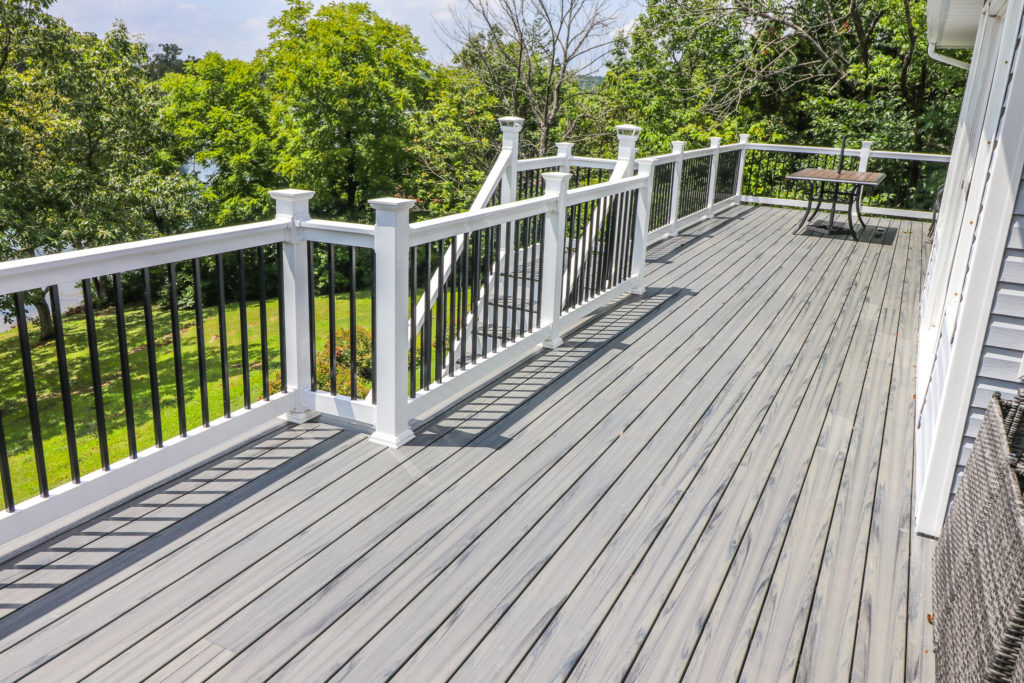
Adding a railing to your outdoor deck
One of the best ways to personalize your composite deck is with the deck railing. Among the most popular options are pre-finished steel or aluminum vertical supports (known as balusters) that are available in various colors to complement the color and design of your deck railings and hardware. Other popular options are clear acrylic or glass panels or steel cables that are run horizontally between or through posts.
A deck railing doesn’t just enhance the appearance of your composite deck; it enhances its safety. In fact, decks more than 30 inches above grade MUST have a deck railing. The national building code specifies a railing height of at least 36 inches, but some states and municipalities have stricter requirements, so always have your plans reviewed and approved before you begin construction. Building codes also dictate the space between balusters so that small children cannot be trapped or injured in the narrow space. Do not space balusters further apart than 4 inches on center.
Maintaining Your Composite Deck

Once you (or your builders) have completed building your outdoor deck, it’s time to start enjoying it. Because composite decking doesn’t warp, split, or rot like treated lumber, maintenance is far simpler. Sweep or hose off the deck regularly to remove any debris such as sand, leaves, or small branches. This not only keeps your deck looking good but also reduces the risk of someone slipping or tripping. A few times each year, give the deck a more thorough cleaning with a mild cleanser and a stiff brush. Or, if you have a gas or electric power washer, you can scrub your deck spotless with minimal effort. It’s important to keep your deck clean and well-maintained so that it stays beautiful for many years to come. If you have added patio tables and chairs, store your cushions when not in use, and cover or store furniture in the off-season.
Summary
Composite decking is one of the most durable, low-maintenance options for homeowners, and at Armadillo Deck, we offer a variety of colors to suit every style. If you’re looking for information about composite decking or want to learn more about our products, click on any link in this article. You can also contact us today if you have questions that we did not address here!

